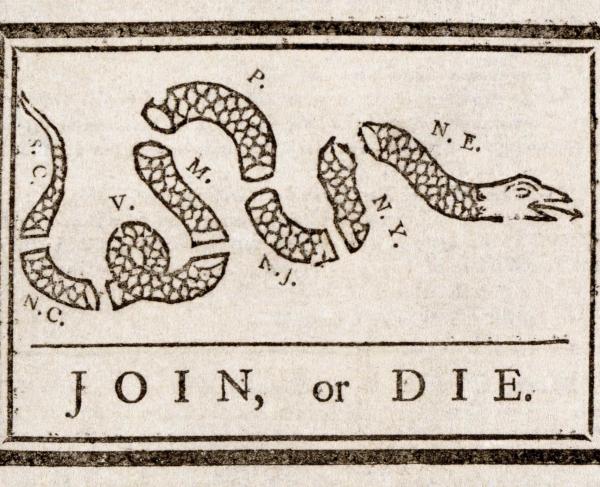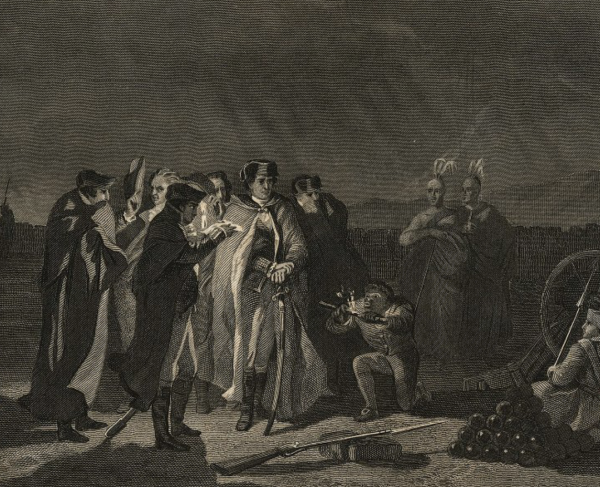
Tensions in North America’s Ohio River Valley had finally reached a boiling point between Britain and France. Lieutenant Colonel George Washington, then just 22 years old, led a detachment of some 40 Virginia soldiers and a dozen Native American allies into the wilderness less than fifty miles from the Forks of the Ohio and France’s Fort Duquesne (present-day Pittsburgh, Pennsylvania). Word had reached the young Virginia officer the previous day, May 27, 1754, that a party of French-Canadian soldiers were advancing towards his encampment in a clearing known as Great Meadows. Their intentions were unknown, but all signs indicated that the enemy detachment had malicious intents. Washington would not wait to find out.

After marching his men through the night to a low glen six miles away, Washington and his command arrived near the French position. Situating his Virginians atop the high boulders overlooking the enemy camp, and sending his Native American auxiliaries to the left and right to block their escape, he prepared his ambush. The order was given to fire, and the loud discharges of musket fire rippled throughout the wilderness and reverberated throughout history as well. After fifteen minutes the smoke cleared, and twenty-one French soldiers were captured or lay wounded below, and ten, including the detachment’s commander, Ensign Joseph Coulon de Jumonville, were dead. One man had escaped the maelstrom, and quickly made his way back to the safety of Fort Duquesne, carrying with him the harrowing news of what had just transpired at what is today referred to as “Jumonville Glen.”
Having in his mind just won a resounding victory over an encroaching enemy force, Lt. Col. Washington gathered his prisoners and returned to his camp at Great Meadows. Little did he know, he had (and one recently discovered Native American account literally states he personally had) fired the first shots of what would develop into a war for the continent between Britain and France, and subsequently, a global war for empire.
The incident at Jumonville Glen has been shrouded in controversy. French officials, including Claude-Pierre Pecaudy de Contrecoeur, the commander at Fort Duquesne, claimed that Jumonville and his detachment were on a diplomatic mission to collect information and request that Washington and his men leave the Ohio River Valley. It was even said that the Canadian officer had attempted to read aloud his summons when Washington opened fire. The details have remained foggy, as both sides told a different story. What was certain, however, was that the French at Fort Duquesne were preparing to retaliate.
One man who personally sought vengeance was Captain Louis Coulon de Villiers, the older brother of Jumonville. After learning the news of his brother’s death, Villiers hastily traveled to Fort Duquesne, arriving at the Forks of the Ohio on June 26. He urged Contrecoeur to give him command of the force being assembled to strike a blow against Washington, and his request was granted. Two days later, Villiers, at the head of 500 Canadian marines and militiamen and between 100-300 Native auxiliaries, set off to seek their revenge. To recruit these Native allies, Commandant Contrecoeur held a gathering and implored that, “The English have murdered my children, my heart is sick; tomorrow I shall send my French soldiers to take revenge. And now, men of the Sault St. Louis, men of the Lake of Two Mountains, Hurons, Abenakis, Iroquois of La Presentation, Nipissings, Algonquins, and Ottawas—I invite you all by this belt of wampum to join your French father and help him to crush the assassins. Take this hatchet, and with it two barrels of wine for a feast.” This presentation of gifts in exchange for military support was a typical method of diplomacy between the Native Americans, French, and British, and during the early stages of the French and Indian War, the French were much more proficient at it. Native warriors were the best scouts and forest fighters on the continent, and their service would help contribute greatly on the battlefield to any side that won their support.
By July 3, the French force had arrived at Great Meadows, where Washington, his 300 Virginians, and 100 South Carolinians under Captain James McKay, which had arrived in June to bolster the expedition, had prepared a crude stockade surrounded by earthen defensive works. Fort Necessity, as the defenses would be dubbed, was anything but an actual fort. At its center stood a circular stockade made of upright standing split logs seven feet in height and about fifty feet in diameter. Within the walls was situated a small shed which housed the ammunition and supplies. Outside, the stockade was defended by several trenches of about four to five feet of earth in height. By the time the battle of Fort Necessity began around eleven in the morning on July 3, terrible rain had turned these ditches into pools of slop and muddy water. These awful conditions would add to the Virginians and South Carolinians’ misery, as many were sick, hungry, and exhausted from weeks of exertion.
When Capt. Villiers led his command into the woods surrounding the open meadow which housed Fort Necessity, shots were exchanged and it was discovered that Washington had advanced about fifty of his men into the open field arrayed in line of battle. Under growing pressure from the sight of hundreds of Canadians and Native Americans manifesting in the woods to their front and flanks, the Virginian pulled his men back within the fort’s trenches. Now surrounded, Washington and McKay’s men huddled closely together making themselves easy targets for the enemy as a sustained exchange of musket fire began through the pouring rain.
The fighting continued until roughly 8 p.m., when Capt. Villiers called for a parlay to discuss the defenders of Fort Necessity’s surrender. Washington and McKay understood that their situation had become hopeless. Nearly one-third of their command had been killed or wounded, their gunpowder was wet, ammunition exhausted, and many of the men had gotten into the alcohol supply and become drunk. All avenues of escape had also been severed by the enemy. Out of options, Washington agreed to hear Villiers’ terms of surrender.

Just like the other controversies that surrounded Washington’s service in western Pennsylvania that spring and summer, what transpired next has been debated by buffs and historians for centuries. Only several men in Washington’s command were proficient enough in French to help communicate with Villiers and translate the surrender documents. During the process a terrible mistranslation or oversight occurred when Captain Jacob van Braam, the man tasked by Washington to serve as the liaison, left out the term l’assassinat, literally meaning the assassin. Villiers had included in his surrender document a provision that would serve as a confession that Washington had ordered the murder of his brother, Jumonville. On July 4, ignorant to its inclusion, Washington signed the paper and admitted to an act of war between Britain and France. His men were allowed to depart for Virginia with their personal baggage, one swivel gun (a tiny cannon), drums beating, and their flags still in their possession. Two hostages were left behind to assure that the captured of Jumonville’s detachment would be returned. The men, Washington included, were forced to promise that they would not return to the Ohio River Valley for a year. The accepted surrender terms had been fairly lenient; after all, the two countries were not officially at war.
The defeat at Fort Necessity had been a terrible moment in the young Washington’s life, but he had learned a lot, and would continue to grow as a man and leader. The next year, he would find himself returning to the site of the battle, Great Meadows, as part of a major British expeditionary force tasked with capturing Fort Duquesne and dispelling the French from the region once and for all. It was his turn for revenge and redemption.
Further Reading:



